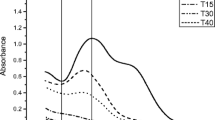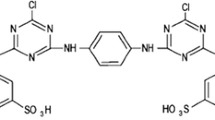Abstract
Textile industry is responsible for a large amount of polluted water released daily, mainly due to the dyes used. This article has aimed to study and improve methodologies for degrading textile effluents containing the dyes Acid Red 151 and Acid Blue 40 using an electrolytic reactor. Different solutions were prepared for the experiments in the electrolytic reactor with a 70 % TiO2/30 % RuO2 anode. The textile effluents underwent 0 (control), 3, and 30 min treatment intervals. A suspension of Saccharomyces cerevisiae cells was used for toxicity tests and performed at the same day that samples were collected. The same test was applied to the samples after 15 days resting in order to verify changes in toxicity. The electrolytic treatment successfully removed the color in all effluents. However, the process efficiency varies according to the dye used and the experimental conditions, such as current and NaCl concentration. Also, it was observed that treatments longer than 30 min are very toxic to S. cerevisiae cells because of the high concentration of Cl2.





Similar content being viewed by others
References
Al-Degs, Y., Khraisheh, M. A. M., Aleen, S. J., & Ahmad, M. N. (2000). Effect of carbon surface chemistry on the removal of reactive dyes from textile effluent. Water Research. doi:10.1016/S0043-1354(99)00200-6.
ANEEL – Agência Nacional de Energia Elétrica. (2012). Tarifas residenciais vigentes (Brazilian Residential Electricity Supply Prices). Resource document. http://www.aneel.gov.br/area.cfm?idarea=493. Accessed 27 Nov 2012.
Catanho, M., Malpass, G. R. P., & Montheo, A. J. (2006). Avaliação dos Tratamentos Eletroquímicos e Fotoeletroquímicos na Degradação de Corantes Têxteis (Evaluation of electrochemical and photoelectrochemical treatments for degrading textile dyes). Quimica Nova. doi:10.1590/S0100-40422006000500018.
Deng, Y., & Englehardt, J. D. (2007). Electrochemical oxidation for landfill leachate treatment. Waste Management. doi:10.1016/j.wasman.2006.02.004.
Georgiou, D., Melidis, P., Aivasidis, A., & Gimouhopolus, K. (2002). Degradation of azo-reactive dyes by ultraviolet radiation in the presence of hydrogen peroxide. Dyes & Pigments, 52(1), 69–78.
Harris, D. C. (2001). Quantitative chemical analysis. Rio de Janeiro: LTC.
Mierzwa, J. C., Silva, M. C. C., Rodrigues, L. D. B., & Hespanhol, I. (2008). Tratamento de água para abastecimento público por ultrafiltração: avaliação comparativa através dos custos diretos de implantação e operação com os sistemas convencional e convencional com carvão ativado (Water treatment for public supply using ultrafiltration: the direct costs of implementation and operation with conventional and conventional systems using activated carbon). Engenharia Sanitária e Ambiental, 13(1), 78–87.
Robinson, T., McMullan, G., Marchant, R., & Nigam, P. (2001). Remediation of dyes in textile effluent: a critical review on current treatment technologies with a proposed alternative. Bioresource Technology. doi:10.1016/S0960-8524(00)00080-8.
Sauer, T., Cesconeto Neto, G., José, H. J., & Moreira, R. F. P. M. (2002). Kinetics of photocatalytic degradation of reactive dyes in a TiO2 slurry reactor. Journal of Photochemical Photobiology A: Chemical. doi:10.1016/S1010-6030(02)00015-1.
Sousa, M. L., & Bidoia, E. D. (2014). Impact f the textile dye acid blue 40 on the periphyton of a simulated microecosystem. Water, Air, Soil and Pollution. doi:10.1007/s11270-014-2025-7.
Sousa, M. L., Moraes, P. B., & Bidoia, E. D. (2011). Photoeletrolytic system applied to remazol red brilliant degradation. Water Science and Technology. doi:10.2166/wst.2011.208.
Steinhart, M. R. V. (2000). Auxiliares têxteis do ponto de vista dos tensoativos (Textile auxiliaries from the point of view of surfactants). Química Têxtil, 61(1), 76–80.
Sussman, S. A. (1974). Microorganismos: crescimento, nutrição e interação (Microorganisms: growth, nutrition and interaction). São Paulo: EDART.
Zanoni, M. V. B., & Carneiro, P. A. (2001). O Descarte dos corantes têxteis (Disposal of textile dyes). Ciência Hoje, 29(174), 61–64.
Acknowledgments
The authors thank FAPESP for the financial support.
Author information
Authors and Affiliations
Corresponding author
Rights and permissions
About this article
Cite this article
de Sousa, M.L., Bidoia, E.D. Electrolysis Applied For Simulated Textile Effluents Degradation Containing Acid Red 151 and Acid Blue 40. Water Air Soil Pollut 225, 2234 (2014). https://doi.org/10.1007/s11270-014-2234-0
Received:
Accepted:
Published:
DOI: https://doi.org/10.1007/s11270-014-2234-0




